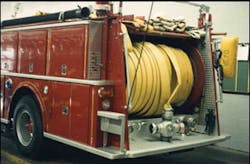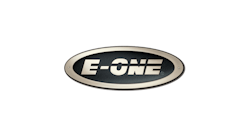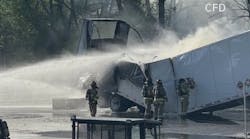It has been said that if you remember the Sixties, you weren’t really there. But, if you remember the Seventies, and are still putting “the wet stuff on the red stuff,†you’ve earned your right to put down your light beer and pick up a cold Harvey Wallbanger while we reminisce about the way we were. So, set aside your Atari video game, turn on the lava lamp, set your mood ring on your pet rock and wander back to that golden age.
During the Seventies, we saw a President resign, disco come and go, the Vietnam War end, and man walk on the moon for the last time. Ads for cigarettes disappeared from TV, and the NFL and AFL merged into a single football league. Americans were held hostage in Iran by terrorists, and in Pennsylvania, by Three Mile Island. For the fire service, it was also a decade of innovation, challenges and change.
When summoned to respond to a “disco inferno,†the well-dressed firefighter exchanged his leisure suit for a turnout coat made of Nomex, one of the first fire-retardant fabrics to replace the old standby, cotton duck. Should his department buy its helmets from Cairns, he began the decade with a traditional leather New Yorker atop his head, then potentially migrated to headgear formed from manmade materials, and named after other cities such as Philadelphia and Phoenix. If he were a volunteer, chances are he donned his firefighting attire while atop the hosebed of a moving apparatus, attempting to pick out items that fit from coat and boot rails mounted high on the sides.
Early in the decade, the hose was probably double-jacketed cotton with brass fittings. By the decade’s end, some of it increased in diameter, lost a jacket and had foreign-looking couplings because, well, they were foreign. And, in a few cases, the hosebed was no longer a bed, but a hydraulic or electrically powered reel. Reels were not just for booster lines anymore. If he belonged to a suburban or larger department after 1970, the rig might be quipped with a TeleSqurt, which was introduced that year.
Our volunteer friend was probably notified of all calls by his home alerting receiver, which was often produced by Plectron – a company no longer in business. This was a decided step up from the former methods of firehouse siren or telephone fan-out system, as the location and type of alarm was now immediately known. Unfortunately, unless you had a very long extension cord, as the name suggests, this device proved beneficial only if you were home and the power was on. This was solved by the time 1980 came around by the increasing utilization of tone and voice pagers.
In addition to knowing his own tones, between 1972 and 1977 the firefighter was also familiar with those of Station 51 from the TV show “Emergency!†While the program is no longer produced, the dispatch audio lives on in the form of a “WAV†file that can still be heard on many fire-related websites. The initial call may have been made through the new 911 emergency number, which began to flourish since its meager beginnings in 1968, or occasionally through one of an increasing number of automatic alarms that were beginning to be required by code in high-hazard locations. Overall, our friend and his counterparts responded to more than 3 million incidents per year nationwide.
In 1972, the firefighter and his family could get an inside view of how the Bronx was burning through Dennis Smith’s best-seller, Report from Engine Co. 82, and in 1973 read the sobering information presented by the National Commission on Fire Prevention and Control, through its report entitled America Burning. In 1974, they watched the potential impact of high-rise fires on the big screen courtesy of “The Towering Inferno.†While some comparisons to this movie arose after 9/11, some notable fires of that decade included the Beverly Hills Supper Club in Kentucky, the Social Security Building in Kansas City and high-rise incidents in Sao Paolo, Brazil.
If not to be found in the hosebed, the firefighter may have ridden to alarms in the jumpseat area, which was then not enclosed. Of course, back in the day, the entire cab itself might also be open, meaning that those wipers on the inside of the windshield were there for more than show. Remember, many apparatus from the 1950s and 1960s were in front-line service. But, more than likely, whether career or volunteer, the firefighter traveled to the call on the side running board of the ladder or back step of the engine, protected by God and a sign that said “Keep Back 200 Feetâ€. Although the Mattydale crosslay was first utilized in the late 1940s, a lot of hose was still coming off the back of engines 25 years later, and crews rode where they would be ready for action.
Enroute to the alarm, traffic was cleared with an electronic siren, which was beginning to make inroads into the mechanical siren market. Of course, like the old fire horse, devices such as the Federal Q remain with us today – because they work. But, during the Seventies, features such as “wail,†“yelp†and “hi-lo†added to the symphony of response, and even added a slightly international tone to the event. Of course, electronic sirens required speakers, and these were often contained in roof mounted light bars such as the Twinsonic, which were also an early attempt at aerodynamic warning signals.
Upon arrival, the well-dressed firefighter donned a self-contained breathing apparatus (SCBA) with an aluminum or steel tank at the beginning of the decade, replacing it with a composite cylinder before the Eighties arrived. However, in the early 1970s, it was not unheard of for the first crew to make an interior attack without respiratory protection because it “saved time.†As soon as the backup crew got the airpacks out of the compartment and then out of the boxes they were kept in, the first-in firefighters were free to go outside to cough, vomit and light up a cigarette. This was the first “two-in/two-out†rule, although it was certainly not what the National Fire Protection Association (NFPA) intended by its later legislation.
Thinking About Safety
Compartment doors opened out or opened up, and a few started appearing in what was known as the “high-side†mode, as hard suctions moved upward. Roll-up doors were found only on the front of the apparatus bay. During this decade, we somehow caught on to the fact that moving breathing apparatus out of our compartments and into areas where they could be easily donned might be a better and healthier way of saving time. The rapid transition from natural to manufactured building materials also helped this transition, as smoke became increasingly toxic. Movement also began toward “positive-pressure†breathing apparatus, which eventually became standard. Without this feature, an improperly sealed mask could actually suck in toxins when the user inhaled.
According to a popular ballad of the time, “God Didn’t Make Little Green Apples,†but somebody sure was busy making a lot of big green fire trucks. Ward LaFrance began this trend in 1971 with the display of a pumper painted this decidedly different shade at the International Association of Fire Chiefs (IAFC) convention. Ward based most of its publicity on firefighter safety and the much-higher visibility of the green spectrum to the human eye compared to the traditional fire engine red. Added to the mix was Dr. Stephen Solomon, an optometrist who also happened to be a volunteer firefighter, who spoke out in favor of the change. For a time, many a fire station became a multi-colored affair as new green apparatus shared bays with their rosy hued elder cousins. While some departments, such as Miami-Dade and Rural Metro, still adhere to green rigs, there has been a progressing but decided twist away from lime.
Not only has the wearing of the green gone by the wayside since the Seventies, but so have many apparatus manufacturers. Ward itself ceased operations in 1979 and its successor, Ward 79, went out of business 10 years later. A partial listing of rigs available in the Seventies that are no longer produced reads like a muster program, and includes Hahn, Young, Crown, 3D, Mack, FTI, Van Pelt, Pierreville, Hamerly, Boyer, Calavar-Firebird, Howe-Oren, LTI, Pirsch, Thibault, FMC/Bean, Beck, Continental, EEI, Pemfab, Sanford, Western States and Grumman.
In addition to big green trucks, the 1970s also saw little trucks of every color. The mini-pumper made significant inroads at this time, with both volunteer and career departments adding these downsized apparatus to their fleets. Beginning in 1974, some of these units had aluminum instead of steel bodies, and were available in fairly short order from an upstart company called E-ONE. Today, E-ONE holds a respectable market share of the entire apparatus market.
During this decade, the fire service became the beneficiary of technology developed for other industries. Just as research for the space program impacted both SCBA and turnout gear, so did the need for rapid extrication at race tracks. In 1972, the Hurst Corporation, famous for its high-performance shifters, created the Jaws of Life, which got its start in this sporting environment, but soon began to appear in the compartments of municipal rigs. Prior to this, most of the work done to disentangle victims was done by hand, with the occasional assist from a power saw, acetylene torch, come-along or manually pumped hydraulic tool. Ironically, may of these devices were also borrowed from other disciplines such as construction or automotive body shops. Today, the Jaws are in service with over 35,000 departments worldwide, with competing rescue products found in thousands more.
Technology also brought us Rapid Water, a polymer additive that reduced friction loss. This was seen as a boon by many, since a significantly greater amount of water could be moved through a smaller handline. New York City was among several agencies to test Rapid Water. It was hoped that fire flows normally generated by three firefighters and a 2½-inch line could be matched by two firefighters and a 1¾-inch line. The experiment, although noble, came to a predictable end considering that it might have reduced staffing on engine companies, and cost $2.75 for every thousand gallons of water flowed. In New York City, during a period of fiscal crisis, that represented a lot more than chump change.
The “Wet Stuff†and More
Using POW (plain old water) most of the time meant application by means of the newly introduced automatic nozzles that adjusted their streams according to available water and pressure. In 1971, Task Force Tips sold its first nozzle, becoming one of many fire service firms to begin business in that era. When not using water, rapid or otherwise, firefighters of that decade had a variety of other extinguishing agents on which to rely. Halogenated hydrocarbon, or Halon for short, was used in both fixed systems and portable extinguishers designed for use on electronic hazards. For flammable liquids, aqueous film forming foam (AFFF) was in vogue. In the ensuing 30 years, concerns over the environmental impact of these agents intervened. Of course, consider the fact that a typical 1970s call classification was the “washdown,†which as the name suggests, involved flushing the street clear of accident debris, including the rinsing of any and all automotive fluids present into the gutter or storm sewer.
But one of the most radical changes seen by our brothers from the 1970s was the addition of firefighting sisters. While women had long held a place in the fire service, traditionally this often involved support or ancillary roles. This is not to say that women had not engaged in active firefighting. Records indicate that they did so as far back as the early 1800s. However, throughout this article, I have intentionally used the term fireman, and the pronoun his, because 30-some-odd years ago, that’s what we called ourselves and because we were almost exclusively male. While now obviously politically incorrect, it is a barometer of those times.
In July 1973, the City of Winston-Salem, NC, hired Sandra Forcier as a public safety officer, and in 1974 Judith Livers was accepted by Arlington, VA, as the first career female firefighter. With that, the gender-neutral term firefighter became permanently ingrained in our vocabulary. In 1978, the FDNY followed suit by accepting its first female probies, as did several other major U.S. cities during this decade. In addition to sexual diversity, attention was also given to racial diversity. In 1974, for example, a consent decree to increase minority employees went into effect in the City of Los Angeles. At that time, LAFD had only 45 African-American firefighters. In the case of both gender and race, the struggle continues today. As of December 2004, FDNY had a total of 28 female firefighters – about one-fifth of 1% of its total staffing, and fewer than in the 1980s. However, much of the effort to change the face of the American fire service took root in the 1970s.
As one who began my fire service career at the beginning of this tumultuous era, I look back with fondness at some of what has been left behind, and also with grateful amazement that more of us did not get killed or hurt by what were clearly uniformed, but nonetheless, dangerous practices. How will the next generation of firefighters view what we do today? Only time and our increasing knowledge of our profession will tell. But in the war stories of 2036, these will surely be remembered as “the good old days.â€
Barry Furey, a Firehouse® contributing editor, is director of the Raleigh-Wake Emergency Communications Center in North Carolina. During his 35-year public safety career, he has managed 911 centers and served as a volunteer fire officer in three other states. Furey is former chair of the Association of Public safety Communications Officials (APCO) Homeland Security Task Force.







